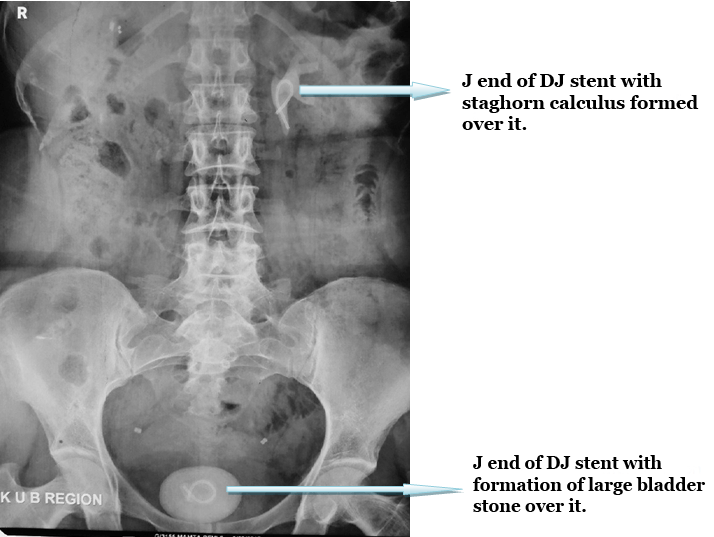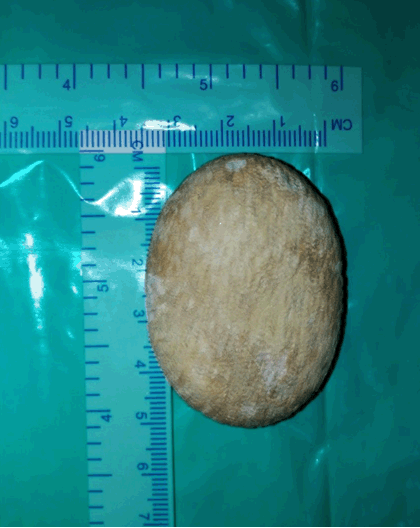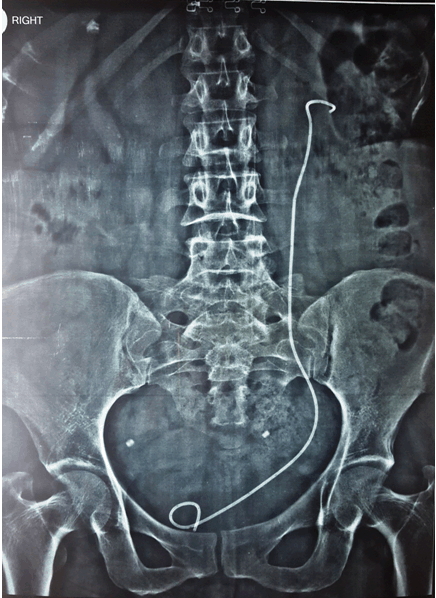
|
 |
|
Case Report
| ||||||
| A forgotten double-J stent with missing shaft and unusual large stone formation at its both the J end: A case report | ||||||
| Rajesh Kumar Maurya1, Vikash Katiar2, Vijay Kannaujiya3 | ||||||
|
1MS, General Surgery, Professor, Department of General Surgery, G.S.V.M. Medical college, Kanpur, Uttar Pradesh, India 2MS, General Surgery, Assistant Professor, Department of General Surgery, G.S.V.M. Medical College, Kanpur, Uttar Pradesh, India 3MBBS, Junior Resident (IIIrd), Department of General Surgery, G.S.V.M. Medical college, Kanpur, Uttar Pradesh, India | ||||||
| ||||||
|
[HTML Abstract]
[PDF Full Text]
[Print This Article] [Similar article in Pumed] [Similar article in Google Scholar] 
|
| How to cite this article |
| Maurya RK, Katiar V, Kannaujiya V. A forgotten double-J stent with missing shaft and unusual large stone formation at its both the J end: A case report. Int J Case Rep Images 2017;8(9):583–586. |
|
ABSTRACT
| ||||||
|
Introduction:
Use of ureteric stents is accepted standard practice in the management of ureteric obstruction, ‘forgotten’ indwelling stents can cause encrustation, pyelonephritis, recurrent obstruction, and stent migration and breakage. A stent register should be maintained to check follow-up of such patient to prevent this urological travesty. Keywords: Bladder stone, Forgotten Stent, Indwelling Stent, Stenturia, Staghorn calculus, PCNL | ||||||
|
INTRODUCTION
| ||||||
|
The double-J ureteric stent has become one of the most basic and valuable tool in urology [1]. The use of ureteric stents is accepted standard practice in the management of ureteric obstruction [2]. ‘Forgotten’ indwelling stents can result in complications such as encrustation, pyelonephritis, recurrent obstruction, and stent migration and breakage [3][4] and hence can results in significant morbidity and financial loss to the patients. We herein report a case of encrustation and large stones formation at both the J end of a forgotten double-J stent. | ||||||
|
CASE REPORT
| ||||||
|
A 35-year-old female presented in our outpatient department for complaints of left flank and lower abdominal pain, burning and increased frequency of micturition for four months. Six years back she had undergone left sided ureteroscopy at some other centre for ureteric stone clearance and after the procedure a double-J stent was placed. Patient did not turn up for stent removal. Two years back she also passed fragments of stent in the urine (stenturia). Ultrasound kidney, ureter, and bladder of the patient revealed essentially right sided normal kidney, while in left kidney there was a staghorn calculus of size about 25 mm, besides it there was a large bladder stone of size about 49 mm. Digital X-ray kidney, ureter, and bladder showed coiled ends of a double-J stent in the left renal pelvis and bladder region with formation of stones over it however entire shaft of the stent was missing (Figure 1). Her KFT was within the normal limit. Patient was managed by antibiotics according to urine culture sensitivity and by open cystolithotomy for bladder stone (Figure 2), and after one month of open cystolithotomy she underwent PCNL for the staghorn calculus, her postoperative recovery was uneventful both the time. Her latest digital X-ray KUB (Figure 3) dated 01/06/2017 showing complete clearance of stone and double-J stent in situ. | ||||||
|
| ||||||
| ||||||
| ||||||
|
DISCUSSION
| ||||||
|
It has became a routine practice in urology to use a double-J stents for various indications, double-J stent was introduced in the year 1978 since then many improvements have been made in its design and composition to minimize patient discomfort, because of it patient can forget regarding the indwelling stent. The rate of complications like fragmentation, encrustation, pyelonephritis, recurrent obstruction and stent migration are significantly related to indwelling time. El-Faqih et al. reported encrustation rate of 9.2%, 47.5% and 76.3% for indwelling time of less than six weeks, 6–12 weeks and more than 12 weeks respectively, they emphasized need for maintaining computerized stent register [3] . Monga et al. concluded that management of such complicated ureteral stents requires a multimodal therapeutic approach, a computerized tracking registry of ureteral stents may help prevent this urological travesty [4]. Kawahara et al. reported similar results, they also concluded that although ureteral stent encrustation was related to the indwelling time, heavily encrusted ureteral stents necessitating additional procedures for removal occurred within an indwelling time of 3 months, the exact interval for removal of an indwelling ureteral stent to avoid additional procedures for removal is therefore difficult to determine [5]. Spontaneous fracture of indwelling ureteral stents can be prevented by careful examination of the stents prior to insertion, by following the instructions of manufacturers on maximum time limits [6]. Successful management of retained ureteral stents requires careful planning and may entail a combination of endourologic approaches [7] . Tunney et al. reported that Silicone was least prone to struvite encrustation, followed by polyurethane, silitek, percuflex and hydrogel-coated polyurethane, in rank order. Similarly, silicone was least prone to hydroxyapatite encrustation, followed by silitek, polyurethane, percuflex and hydrogel-coated polyurethane [8]. Kumar et al. showed that mean indwelling time for spontaneous stent fragmentation was 3.5 months only [9]. In case of our patient indwelling time was six years, so we conclude that due to encrustation and stone formation, both ends of the stent were retained in situ and the central shaft was fragmented and passed along with urine (stenturia) and disappeared [10][11][12][13]. | ||||||
|
CONCLUSION
| ||||||
|
In a nutshell, we conclude that although double J stent is an essential tool in quiver of an urologist, their use should be done with caution, patient should be well informed regarding their benefit and harm, A stent register should be maintained to check follow up of such patient, and if there is need of prolong stenting it should be changed after every 12 weeks. | ||||||
|
REFERENCES
| ||||||
| ||||||
|
[HTML Abstract]
[PDF Full Text]
|
|
Author Contributions
Rajesh Kumar Maurya – Substantial contributions to conception and design, Revising it critically for important intellectual content, Final approval of the version to be published Vikash Katiar – Analysis and interpretation of data, Revising it critically for important intellectual content, Final approval of the version to be published Vijay Kannaujiya – Acquisition of data, Drafting the article, Final approval of the version to be published |
|
Guarantor
The corresponding author is the guarantor of submission. |
|
Source of support
None |
|
Conflict of interest
Authors declare no conflict of interest. |
|
Copyright
© 2017 Rajesh Kumar Maurya et al. This article is distributed under the terms of Creative Commons Attribution License which permits unrestricted use, distribution and reproduction in any medium provided the original author(s) and original publisher are properly credited. Please see the copyright policy on the journal website for more information. |
|
|






